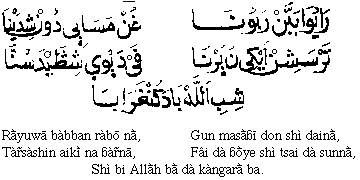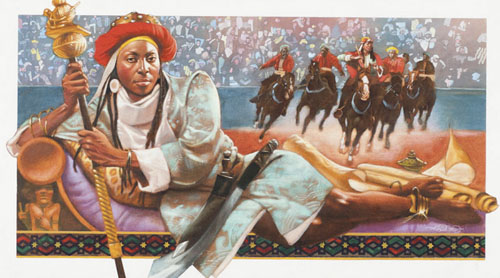Written by Rochelle Guida
In the above photo: Lagos, Nigeria, a city where Hausa is widely spoken
CASLT’s Discovering Languages series aims to spark interest in plurilingualism and pluriculturalism among language learners, school communities, and the public. Each featured language is explored in a blog article and accompanied by a classroom-ready activity for language teachers. Use these activities to promote and popularize language learning among your students and help them develop intercultural competencies.
Hausa and its International Influence
The Hausa people, “one of the largest ethnic groups in Africa,” include half of the Niger population and one-fifth of the people in Nigeria. The Hausa people are predominantly of Muslim faith and many continue to practice pilgrimages to Islamic holy cities.
The Hausa language is considered “the most important indigenous lingua franca in West and Central Africa, spoken as a first or second language by about 40–50 million people.” Hausa is rooted in the Chadic language family. It is the eleventh most spoken language in the world, one language below French in terms of popularity.
Hausa has several interesting linguistic features. It follows a subject-verb-object pattern, with “34 consonants [and] 13 [vowels].” While Hausa is a gendered language of masculine and feminine words, it has about 40 non-gendered plural forms. Hausa is a tonal language, of which speakers either have a high, low, or falling pitch. Humboldt University in Berlin provides the following examples of how tone is incorporated in this language:
High tone is left unmarked. Low tone is indicated by a grave accent (`) while falling tone is a combination of high and low and is indicated by a circumflex (^). These tones are extremely important in distinguishing meanings and grammatical categories. For example,
| Bàaba (LH) | Father |
| Baabà (HL) | Mother |
| Baabaa (HH) | Indigo |
| Dà (L) | And/with |
| Dâ (F) | Formerly/before |
The language has several dialects, along with Standard Hausa. Hausa was already following literacy practices “several centuries before contact with Western culture,” at approximately the 17th century AD. In terms of its writing style, Hausa follows two alphabet types: Ajami and Boko. The Ajami alphabet was established in the 17th century, derived from Arabic tradition, and continues to be used in Islamic schools or for writing poetry. Boko, established in the 20th century, follows a Latin alphabet system and is considered a secular writing form.

Hausa has been taught outside of Africa “since 1885, when the first course was offered in Berlin.” Today, Hausa language teaching may be found at universities with a department of African languages. It is also an influential language on radio stations including “the BBC, Radio France Internationale, China Radio International, Voice of Russia, Voice of America, Deutsche Welle, and IRIB.”
The Feminist Legacy of Queen Amina
One of my dear friends is originally from Nigeria. When asked to share her thoughts regarding Hausa culture, she immediately cited Queen Amina (1533–1610) from Zazzau, or present-day Zaria. She told me that Queen Amina is one of the most notable figures in Hausa culture since she was a warrior queen, leading her people in battle against the British and Arab colonizers. Many Nigerians continue to respect Queen Amina as a proto-feminist before Western influence.

From a young age, Amina was known to be holding a dagger. Her grandfather observed this interest and helped her initiate military training. She began fighting for her people and continued helping her brother, the king. When she eventually ascended the throne herself, she refrained from engaging in romantic relationships and preferred fighting for her people. She reigned for over 30 years, expanded her territory through trade, making a lasting impression on the Nigerian community.
Queen Amina has also been represented in literature and film including a novel (Queen of Zazzau [2018] by J.S. Emuakpor), a graphic novel (Malika: Warrior Queen [2017] by Roye Okupe), video games (Age of Empires III: Definitive Edition and Europa Universalis IV), the feature film Aminaon Netflix, and an 8-minute film on YouTube entitled “The Incredible Story of Queen Amina, Most Powerful African Warrior Queen of All Time.”
Celebrating Powerful Women Warriors in Multiple Languages
Queen Amina: A Warrior Queen of West Africa
About 80 minutes
Objective: Students will learn about Queen Amina — a powerful queen from the 16th century in what is now Nigeria — and her legacy, comparing it with a similar female warrior of the studied target language and/or the native language of the students.
Level: Intermediate to advanced language level of the target language.
Language focus: Vocabulary related to historical figures and events, reading comprehension, discussion skills.
Materials
- Resources about Queen Amina in the target language of the class. For example, Samirath Lawani, of the Centre de l’identité et de la Culture Africaines, has produced the web page “Amina de Zaria: La reine guerrière” and Netflix has produced the feature film Amina.
- Map of West Africa
- Pictures of Queen Amina and her kingdom
- Worksheet with comprehension questions from the chosen source. Here is an FSL example using “Amina de Zaria: La reine guerrière”:
| Question | Answer | |
| 1. | Qui est Amina de Zaria? | Amina de Zaria est une reine guerrière Haoussa de Zazzau. |
| 2. | Quel est le nom actuel de la ville de Zazzau? | Le nom actuel de la ville de Zazzau est Zaria. |
| 3. | Quand est-ce qu’Amina est née? | Amina est née autour de l’an 1533. |
| 4. | Comment a-t-elle découvert sa passion? | Amina a découvert sa passion en faisant des jeux de combat. |
| 5. | Quel est le titre qu’elle a reçu pour son 16e anniversaire? | Amina a reçu le titre de magajiya, qui veut dire princesse, pour son 16e anniversaire. |
| 6. | Quelle est la signification du titre de « habe »? | Le titre de « habe » est donné aux dirigeants de Zazzau. |
| 7. | Combien de soldats Amina a-t-elle commandés? | Amina a commandé une armée de 20 000 soldats. |
| 8. | Pourquoi Amina a-t-elle lancé une série de conquête une fois couronnée? | Amina a lancé une série de conquête pour étendre son royaume et conquérir de nouveaux territoires. |
| 9. | Quelles villes Amina a-t-elle conquises? | Amina a réussi à s’emparer des villes du Nord autour de Kwararafa, du Sud de Nupe et une partie du nord du Mali. |
| 10. | Comment Amina est-elle surnommée après avoir été nommée « habe »? | Amina est surnommée “la Reine Guerrière des Haoussa” après avoir été nommée « habe ». |
Procedure
Introduction (10 minutes)
- Start by asking the class if they have ever heard of Queen Amina. If they haven’t, give a brief overview of who she was and what she is known for.
- Show pictures of Queen Amina and her kingdom and ask students to describe what they see. Encourage them to use descriptive vocabulary related to clothing, weapons, and architecture.
Reading and Comprehension (30 minutes)
- Give each student a copy of the text about Queen Amina and the worksheet with comprehension questions.
- Ask students to read the text silently and answer the questions individually.
- After 15–20 minutes, ask students to work in pairs or small groups to compare their answers and discuss any discrepancies.
- Go over the answers as a class, clarifying any vocabulary or concepts that students struggled with.
Discussion (30 minutes)
- Using the map of West Africa, show students where Queen Amina’s kingdom was located and ask them to brainstorm why this location was strategic for trade and warfare.
- Using a visual diagram or table, have students compare Queen Amina with another female warrior or similar leader who lived in the target language of the classroom and/or of a leader from the students’ home cultures. Have students individually draw comparisons from the women in point-form or in complete sentences.
- Encourage students to use language related to expressing opinions and giving reasons, such as “I believe that . . .” and “In my opinion . . .” in the target language of the classroom throughout the discussion portion of this activity.
Wrap-Up (10 minutes)
- Ask students to reflect on what they found most interesting or surprising about Queen Amina and her legacy. This might look like a ticket out the door activity.
Assessment
- Comprehension questions on the worksheet
- Participation in the group discussion
Extension Activities
Ask students to research other warrior queens throughout history and compare their leadership styles and legacies. The focus should be warrior queens of the target language of the classroom. For example, Boudica of Roman-era Britain or Joan of Arc of 15th-century France. Also, check The Warrior Queen Project website for more ideas, like Mulan of 5th-century China and the Trung sisters of 1st-century Vietnam.




